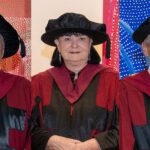The John Curtin Gallery presents the latest exhibition of this historic collection of Carrolup artworks as part of the Great Southern Regional Tour of the Koolark Koort Koorliny (Heart Coming Home) project. It is being held in Katanning from 19 September to 10 October 2015. This year marks the centenary of the establishment of the Carrolup Native Settlement in 1915.
These artworks were created by Aboriginal children of the Stolen Generations, being taught at the Carrolup Native Settlement’s School between 1946–1950. Koolark Korl Kadjan (Spiritual Return Home) aims to bring communities together to share their stories, so we can all reflect upon the events that have occurred throughout Carrolup’s history to understand the sadness of the past and, through celebrating this unique collection of artwork, be inspired to work together to achieve healing and enduring reconciliation.
The exhibition will be supported by selected voices and memories of people who lived at Carrolup as well as their descendants and family members captured in oral histories and a short documentary by Dr Michelle Johnston and Professor Anna Haebich from Curtin University’s School of Media Culture and Creative Arts.
The Great Southern Regional Tour will also comprise tours of The Kodja Place museum, Kojonup which will feature voices, photographs art and objects from Kojonup’s Noongar and non-Aboriginal settler cultures.
The chance discovery of this unique historical collection in storage at Colgate University, Hamilton, New York in 2004, created headlines around the world. Becoming a catalyst for deep cultural exchange between Colgate and Curtin Universities and the Noongar community of WA, the Collection was generously donated to Curtin University in 2013 in a momentous gesture of cultural respect from Colgate University. This transfer of custodianship to Curtin acknowledged the profound importance of these artworks for Noongar communities Western Australia.
John Curtin Gallery Director Chris Malcolm said Curtin and Colgate were proud to preserve the collection for all future generations as a profoundly valuable resource for research and education and will continue on to the next stage of the Regional Tour to provide ongoing access to the artworks for the Noongar communities of WA’s Great Southern region.
The extraordinary artworks were created as part of an inspired teaching program devised by Carrolup School Headmaster, Mr Noel White, to alleviate the suffering of Aboriginal children, forcibly removed from their parents and incarcerated at the Carrolup Native Settlement in accordance with the Government’s policy of assimilation in the late 1940s. Soon after the newly appointed Carrolup School teacher and Headmaster, Noel White and his wife Lily arrived at the settlement with their three young children in May 1946, their Carrolup student’s interest in drawing was quickly recognised and encouraged as a means of promoting communication between teacher and pupils. The White’s quickly set about enabling the children in their care to further explore this interest through an insightful connection to their natural surroundings. Noel White would take groups of the boys, aged between 7 and 14, into bushland around the settlement on bushwalks they called ‘rambles’. When returning to the classroom, he urged the children to simply draw what they saw and although the children had no formal training in art as such, they soon developed striking and distinctive styles and within a few years their artworks were receiving universally positive, critical acclaim.
Many of the artworks feature the Katanning countryside, native animals and hunting scenes.
Visiting English philanthropist Florence Rutter visited the School at Carrolup several times and purchased a group of works between 1949–1950 to promote the artworks across Australia and New Zealand as well as back in Europe. Her intention was to develop a source of support that would directly benefit the children at Carrolup to pursue their artistic endeavours and she organised several exhibitions in Europe with works being purchased for art collections around the world and raising the profile of these artworks.
Sadly after little more than three and a half years, Noel and Lily White’s inspiring leadership at Carrolup came to an abrupt end with the sudden closure of the Settlement School in December 1950. These artworks produced during this brief time at Carrolup between 1946–1950, provide a glimpse of this dark yet extraordinary period in our history.
Towards the end of her life, Florence Rutter’s remaining personal collection of Carrolup artworks was subsequently purchased in 1956 by New York art collector Herbert Mayer (a 1929 Alumnus of Colgate University). Mayer subsequently donated the entire collection to Colgate University in 1966. It remained virtually unrecognised in storage at the Picker Art Gallery at Colgate University, New York, until part of the collection was rediscovered by chance by visiting Australian academic Howard Morphy in 2004.
The Herbert Mayer Collection of Carrolup Artwork was generously donated to Curtin University, Perth, Australia in May 2013 for educational and research purposes by Colgate University, Hamilton, New York, United States of America. The John Curtin Gallery will present further exhibitions of artworks from The Herbert Mayer Collection of Carrolup Artwork throughout the Great Southern region of Western Australia until 2018.



